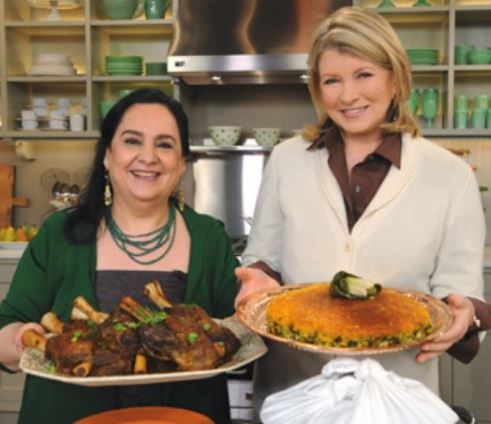By Tara Biglari
Two years of planning and five years of travels: that’s the effort that went into Najmieh Batmanglij’s latest cookbook. Titled “Cooking in Iran: Regional Recipes and Kitchen Secrets,” the 728-page hardback offers an in-depth look at the myriad ways Iranians cook across the country.
[aesop_image img=”https://kayhanlife.com/wp-content/uploads/2019/04/nb1.png” panorama=”off” align=”center” lightbox=”off” caption=”Photo of cookbook Cooking in Iran. ” captionposition=”center” revealfx=”off” overlay_revealfx=”off”]
[aesop_image img=”https://kayhanlife.com/wp-content/uploads/2019/04/nb4.png” panorama=”off” align=”center” lightbox=”off” caption=”A photo from the book Cooking in Iran showing a merchant in an Iranian market.
” captionposition=”center” revealfx=”off” overlay_revealfx=”off”]
From the hills of Baluchestan to the marshes of Khuzestan, Najmieh travelled to all 31 provinces in Iran to eat with the locals, fish with the fishermen and cook with the native delicacies.
“Each region has their own tastes,” she explained during a recent talk at Politics and Prose in Washington, D.C., which was buzzing with attendees of all ages, and so packed that dozens of people were standing at the back. “And the best part: they don’t know about each other.”
[aesop_image img=”https://kayhanlife.com/wp-content/uploads/2019/04/nb3.png” panorama=”off” align=”center” lightbox=”on” caption=”A photo from the book Cooking in Iran showing farmers at work in the Caspian region.” captionposition=”center” revealfx=”off” overlay_revealfx=”off”]
In the book, Najmieh talks about the different causes for celebration across the many provinces. For Kerman, it is the pistachio harvest; Yazd, the pomegranate harvest; and Khorasan, the saffron harvest. These fruits, vegetables and spices are therefore more present in certain local dishes, and their methods of preparation and cooking vary across Iran.
Najmieh was born and raised in Tehran, and always loved cooking, but her mother wouldn’t let her in the kitchen until she finished college. It was only then that she picked up tips and tricks from her mother, aunt and grandmother, memories she fondly recalled during the talk.
[aesop_image img=”https://kayhanlife.com/wp-content/uploads/2019/04/nb2.png” panorama=”off” align=”center” lightbox=”off” caption=”Photo taken during a meal with Iranian women, eating a variety of traditional dishes. ” captionposition=”center” revealfx=”off” overlay_revealfx=”off”]
After the 1979 Revolution, Najmieh moved to France, where she exchanged recipes with her neighbor, who made the best ratatouille in town. “It took me a week to translate one recipe!” she laughed. It was there that she published her first book, Ma Cuisine d’Iran.
Najmieh’s success through publishing cookbooks, including the now-classic Food of Life, has gained her a reputation as “the goddess of Iranian cooking,” in the words of the renowned chef Yotam Ottolenghi. Her books touch on Silk Road cooking, the commonalities between the approach to wine in Italian and Iranian culture, and vegetarianism in Persian cuisine, which have won awards and led her to teach at the Culinary Institute of America in Napa Valley, California.

The desire to travel around the vast expanse of Iran and learn first-hand from grandmothers and local kitchen owners— “sharing tables, and feeling the actual taste in Iran” — drove Najmieh to write her latest cookbook.
The publication includes hundreds of recipes, along with striking photographs of the local people and landscapes. Throughout the book, Najmieh shares anecdotes, such as how some Iranian villagers will have a funeral when a date tree dies, or how she cooked all day with her guide’s family in Kurdistan and ate on a rug under a fig tree to enjoy their meal.
In Cooking in Iran, the author also goes into specific detail about the variations in flavor across each region: for example, how saffron pancakes are the norm in Khorasan, and how warming foods made with pumpkin are more present in the colder areas of Hamadan.
“What touched my heart most was the women of Iran,” she explained during the talk. “I met them in universities, in the tea fields, barbary groves, standing in line to buy bread, weaving carpets in the market.”
[aesop_image img=”https://kayhanlife.com/wp-content/uploads/2019/04/nb5.png” panorama=”off” credit=”Photo credit: Najmieh Batmanglij.” align=”center” lightbox=”off” caption=”A portrait of Najmieh in her home kitchen in Washington, D.C. ” captionposition=”center” revealfx=”off” overlay_revealfx=”off”]
After the Politics and Prose talk, which was accompanied by the photos in the cookbook, attendees asked a range of questions during the Q&A, wondering what cookware she used, how to use dried limes and, amusingly, why jello was a common dessert dish in many parts of Iran. As the evening drew to a close, Iranian and non-Iranian attendees alike left with a drive and determination to venture deeper into Persian cooking.
For more information on Cooking in Iran, visit Najmieh’s website at the link below:

